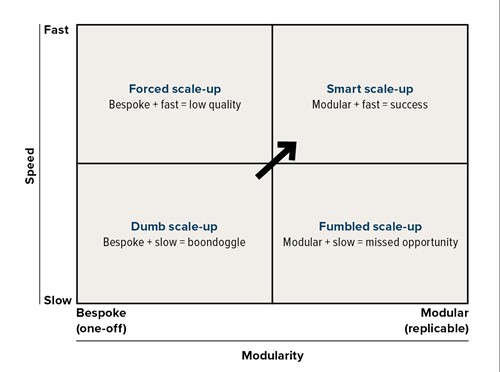Association for Project Management
|
|
Why we need ‘smart scale-up’ to deliver cities of the future
Blog posted by: Bent Flyvbjerg, 17 Jun 2021.

COVID-19 and the 2050 net-zero climate targets force us to rethink how we procure, provide and use urban infrastructure. Cities like London need to find new uses for vacated retail and office spaces. Others aim to shift from car transport to increased cycling and walking. Green electrification is a main trend in mitigating the climate crisis, from cars to homes to industry. Digitisation is everywhere.
Cities of the future have been imagined, from Le Corbusier’s 1925 Plan Voisin for Paris to Bjarke Ingels’s 2020 Masterplanet project. History has not been kind to such attempts. Cities don’t scale well when the scaling is done top-down and in terms of big, bespoke projects, which tend to be slow, bureaucratic and ill adapted to user needs. For city development to work, it must be small-scale, agile and rapidly replicable.
Today, we see a deep contradiction between, on the one hand, slow top-down developments that end up unfit for purpose and, on the other, innovations that work and are applauded by users, but that struggle to scale. We find this pattern not just for cities, but for major projects in general. Therefore, to succeed in building cities of the future, we need projects that scale from the bottom up. We need smart scale-up.
The key to smart scale-up is projects that are designed and delivered (see figure):
- In a modular, replicable fashion.
- At speed.

First, regarding modularity, successful approaches are frugal and work with just a few high-quality standard designs that can be quickly built and replicated over and over, like LEGOs, at any scale, from the smallest to the largest. Wind turbines and solar cells – that scale from cell to panel to row to field to farm to farms of farms – are exemplary, which explains their success in driving down electricity prices and CO2 emissions.
We need to learn from this in building other kinds of infrastructure and in constructing homes, schools, hospitals, offices, hotels, etc. The good news is that it is already happening. The bad news is that it’s happening too slowly, especially when judged against urgent climate targets and the targets for building back after the pandemic.
Modular replicability
Replicability is core to the idea of modularity. Research shows replicability is crucial to effective learning. It creates a feedback loop where you can use the experience from delivering one module to improve the next, ensuring that the quality of delivery improves constantly. The approach was recently used successfully for Hong Kong’s new Infection Control Centre.
Replicability is also conducive to experimentation. Instead of going full scale immediately, you experiment with a few modules and use the experience to improve later modules. You repeat this until you master delivery, which is when you go full scale. Labs are the current frontrunner for experiments. The ability to experiment and learn is the most basic explanation of why a venture that is based on modular replicability is more likely to succeed than a venture that depends on a one-off, bespoke construct that can only be delivered in one go. Think nuclear power and big dams versus wind and solar.
Second, speed is of the essence. Neither design, negotiations, decision-making nor delivery can be allowed to drag on for years, as is typical for large programmes. But it should be emphasised that, despite the need for speed, projects should not be fast-tracked. With fast-tracking, delivery starts before designs and plans are completed. However, fast-tracking is a notoriously high-risk strategy, because the chances of making wrong decisions multiply without a firm design.
The motto here is: ‘Think slow, act fast.’ If you skimp on thinking, it will slow you down later and nothing is saved. With replicable modules, once you have thought through the first few, and learned from experimentation and first delivery, there will be less thinking necessary for each additional module, with replicability enabling speed and economy.
A matter of degree
You can make yourself and your organisation hugely more valuable if you first become clear about your current position. Are you delivering a bespoke, one-off solution or a replicable, modular one? Are you delivering slowly or at speed? Then, move your focus and your activities systematically and effectively towards smart scale-up, the upper-right-hand quadrant in the figure above.
Smart scale-up is not an either-or proposition, but a matter of degree. Your organisation will have elements of each. Your task is to increasingly and tenaciously tip the balance towards smart by introducing smart-scaled ventures and characteristics of smart scale-up into existing ventures. This will be key to meeting climate targets, building back after COVID-19 and delivering the cities of the future.
A version of this blog appears in the summer 2021 edition of Project journal, an exclusive benefit for APM members.
You may also be interested:
- Smart cities, urbanisation and connectivity
- How to make your project a success with Bent Flyvberg (APM Podcast)
- Diving into the latest project news in Project journal
About the Aurthor
Bent Flyvbjerg
Bent Flyvbjerg is BT professor and chair of major programme management at Saïd Business School.
Co-author of the blog 'Tokyo 2020: what the postponed Olympics can teach us about crisis response', and 'Why we need ‘smart scale-up’ to deliver cities of the future'
Alexander Budzier is a fellow in management practice in the information systems at Saïd Business School.
Original article link: https://www.apm.org.uk/blog/why-we-need-smart-scale-up-to-deliver-cities-of-the-future/
- RESOURCES
- MEMBERSHIP
- CHARTERED STANDARD
- QUALIFICATIONS AND TRAINING
- JOBS AND CAREERS
- NEWS AND OPINION
- COMMUNITY
- EVENTS
- BOOKS


.gif)